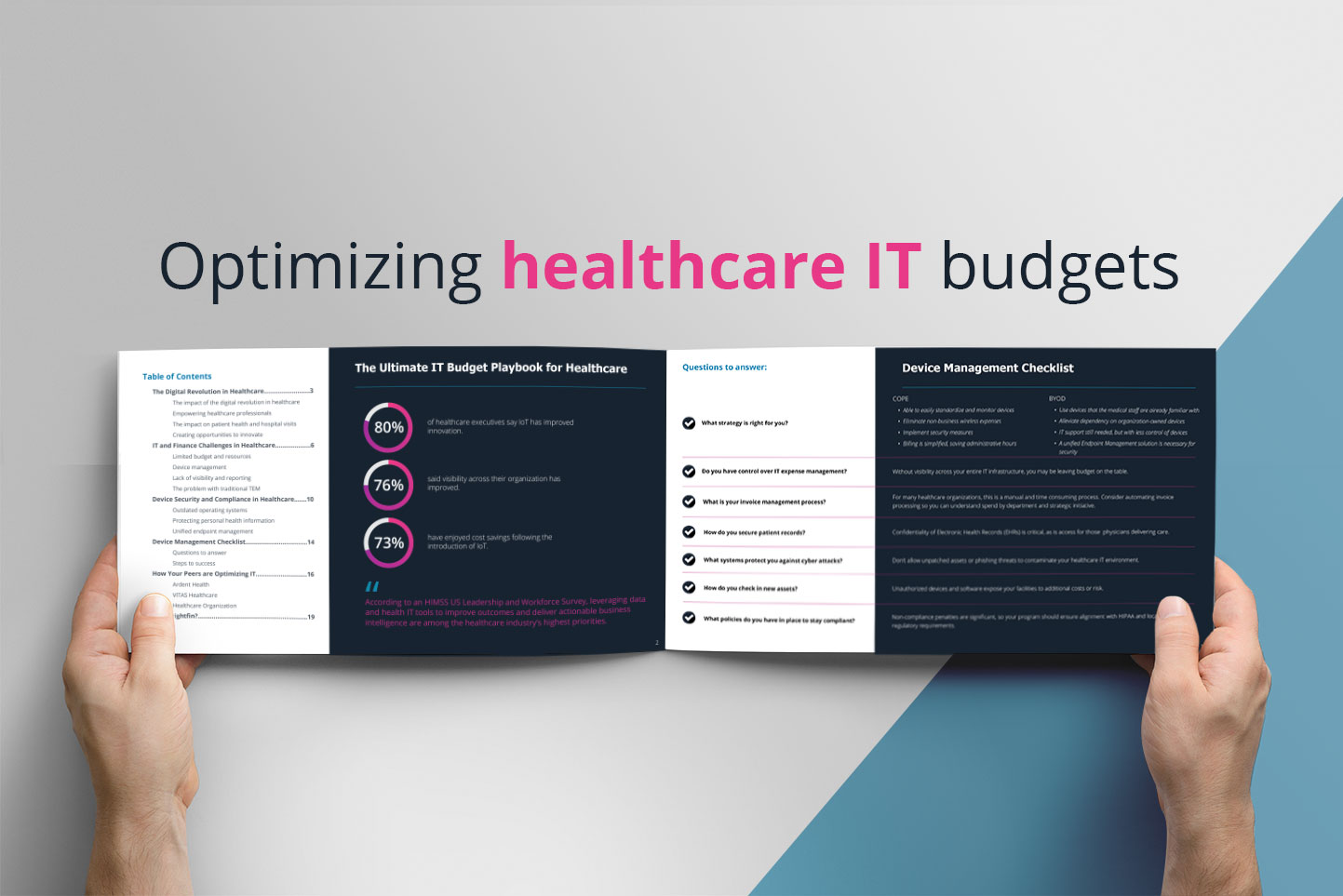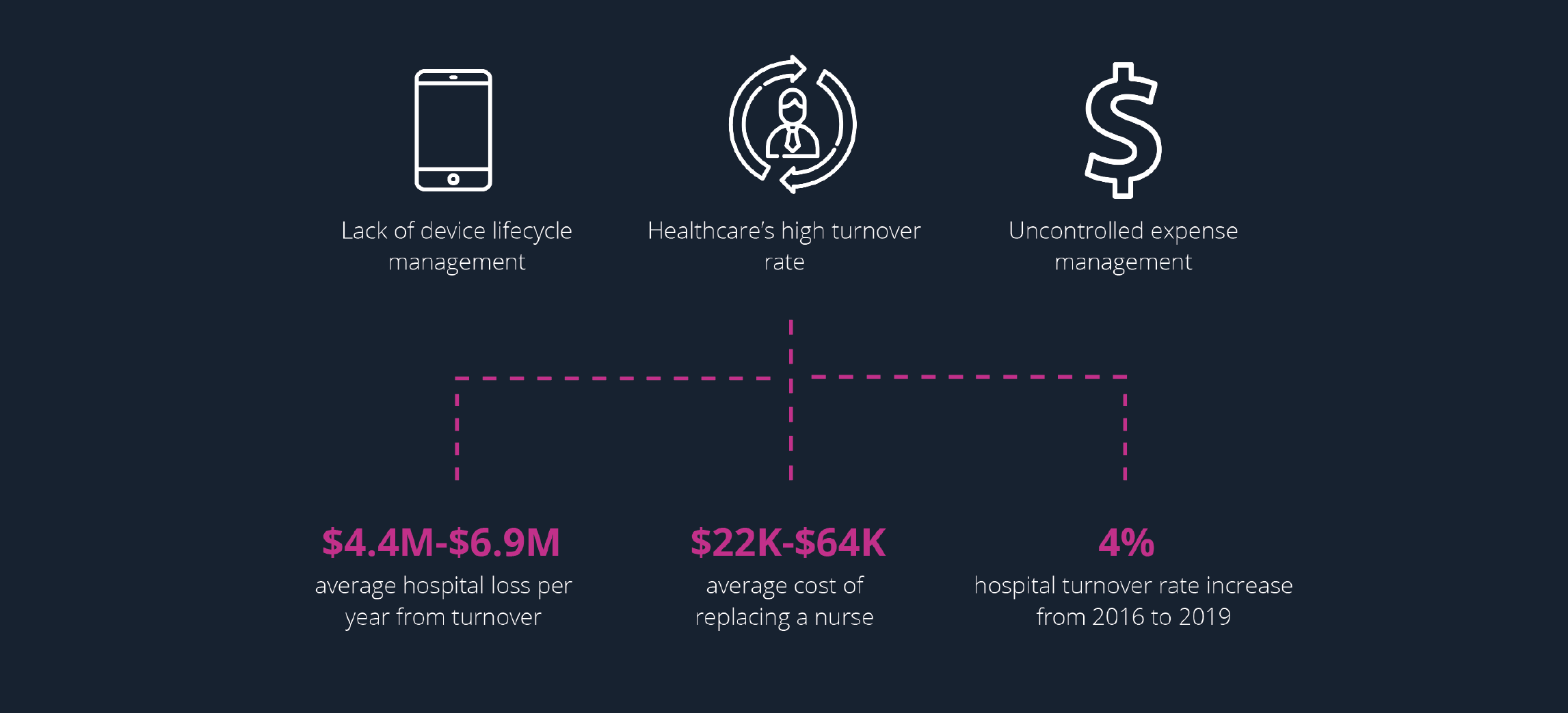The impact of the digital revolution in healthcare
It’s no secret that the ongoing digital revolution has wide-reaching impacts across all industries. However, the healthcare sector may have the most to gain. From doctors embracing mobile devices to deliver better patient care, to connected IoT devices such as wearables and smart hospital beds, the proliferation of technology in the healthcare space is creating incredible new opportunities to improve patient care. It’s also affecting your organization’s bottom line.
According to an HIMSS US Leadership and Workforce Survey, leveraging data and health IT tools to improve outcomes and deliver actionable business intelligence are among the healthcare industry’s highest priorities.

Download the full guide with actionable checklists to help optimize your IT budget
Empowering healthcare professionals
Mobile technology and mobile health apps enable doctors and patients to communicate efficiently, share critical data, and manage healing and wellness in powerful new ways. It’s now a common sight for physicians to securely text message patients from their iPhone, or update a patient’s electronic health records on a tablet. This type of instant access improves the patient experience.

By leveraging connected devices, doctors can make more informed decisions and communicate information directly back to the network. Surgeons can track their patients’ progress post-operatively through the use of mobile apps that send patients follow-up questions. These apps ask patients to check in regularly and relay information back to the clinic for provider review which can drastically improve health results. Many healthcare facilities and clinics have also invested in mobile computing carts that enable doctors and nurses to access electronic health records (EHR) from the patient’s bedside. This allows the doctor and patient to spend more time face-to-face as EHRs are updated.

The impact on patient health and hospital visits
For many patients, overnight hospital stays are prohibitively expensive. Mobile technology is helping to reduce the length of the average hospital stay in the United States. Wearable devices empower physicians to send their patients home earlier, track their conditions with remote monitoring, and reduce the overall cost of hospital visits while enhancing the availability of hospital beds at their healthcare facilities.

With a focus on patients with a high risk of readmission, an Arizona hospital ran a pilot program leveraging smartphones and biometric health monitoring devices in the hands of patients so they could better control their health and recovery. Patients used a mobile application to remotely participate in care management programs. The patient’s health care professionals received triggered alerts if their patient’s health status was deteriorating.
The program reduced hospital charges per patient by an average of $92,317 over a 6-month period, while simultaneously reducing average days of hospitalization from nearly 14 days to just over 5 and nearly halving the total number of hospital visits. An additional study from researchers at the Perelman School of Medicine at the University of Pennsylvania concluded that patients whose providers used secure mobile text messaging left the hospital about 0.77 days sooner, equivalent to about a 14 percent reduction in their overall hospital stay.

Creating opportunities to innovate
Technology creates powerful new opportunities for hospitals to innovate patient care while reducing costs and driving better adoption. Connected devices in hospitals allow physicians to better engage with patients. And with telemedicine, patients can access the care they need from wherever they are. Wearable devices can monitor at-risk patients while minimizing costs throughout the healthcare system.
The benefits for patient care and clinicians are clear. While the digital revolution empowers clinicians and patients, it also causes challenges for healthcare organizations to optimize spend, keep budgets in check year-over- year with IT expense management, and to properly allocate IT spend to the correct places.
Unmanaged IT spend represents a significant opportunity for savings. Without the right visibility and cost allocation, these unused savings often get left on the table.

“C-suite decision-makers want to redesign their operating models while looking at technology to potentially boost cost savings. These continued cost pressures drive leaders to seek tech leverage.”
David Chow
Article in Forbes
IT and finance challenges in healthcare
Limited budget and resources
Healthcare service providers are required to make important decisions about how they spend their limited resources. Should you spend your money on crucial technology upgrades, medical staff, and necessary supplies? Or should you allocate your money on specialized IT security staff, training, or software? This decision is a reality that many healthcare service providers are faced with.
“The biggest challenge is being able to integrate operating and capital budget plans with the larger strategic vision as opposed to getting wrapped up with balancing the budget and losing the broader focus,” Jason Sussman, partner with Skokie said. “It’s a holistic look at getting the proper balance. Instead of saying ‘We’ll cut 10 percent across the board,’ take a look at whole service areas and determine whether you need to provide it at all.” The optimal formula, he says, should include combining productivity, efficiency and quality – and being able to create the metrics to track them.
Global IoT in healthcare is expected to rise to $332 billion by 2027
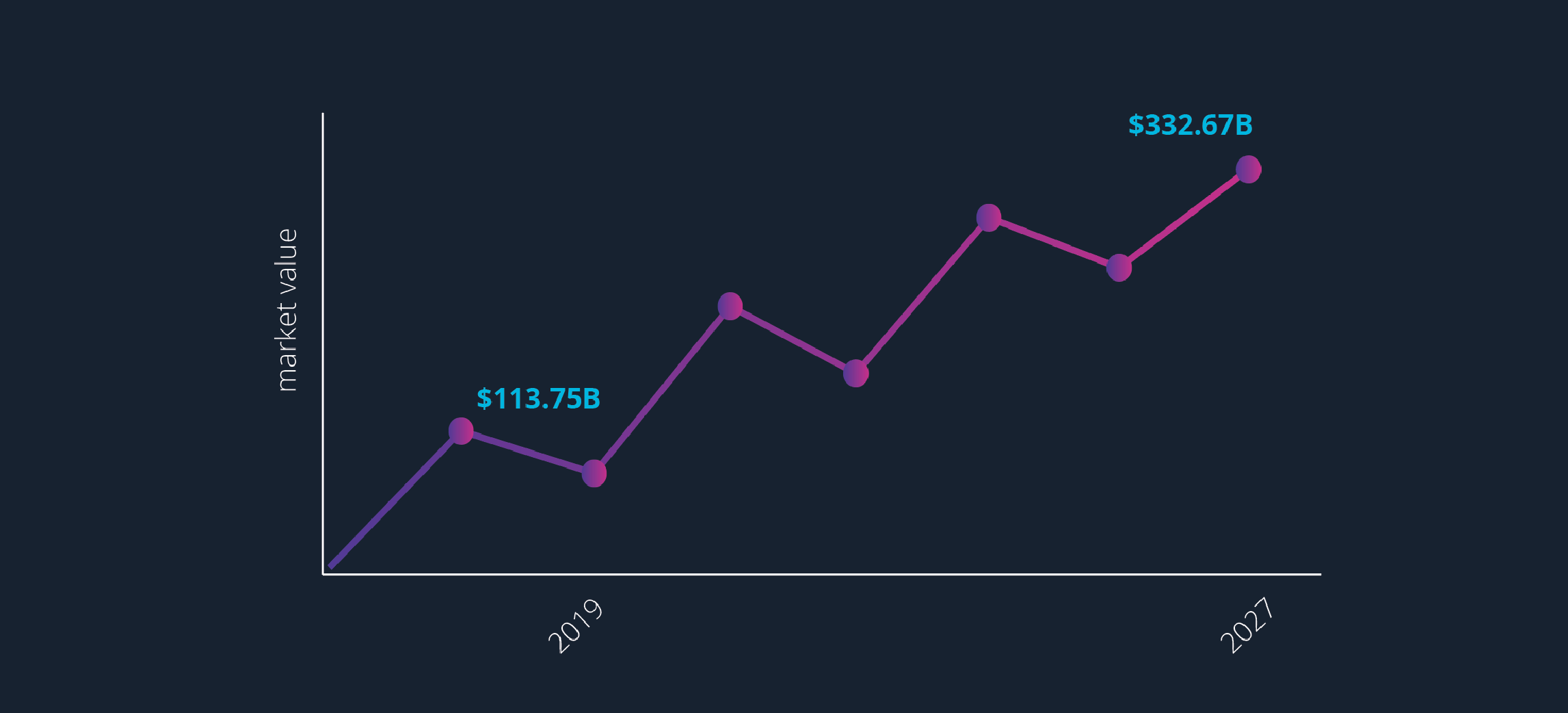
Device management
Medical device management, including maintenance and documentation, is a critical step in managing the IT needs of a healthcare organization. All medical devices with an electrical plug must be inspected by a biomedical engineer on a yearly basis. Documentation of the assessment, location, software, and hardware version must be maintained within the system of record.
Device firmware and software updates is another key element in maintaining a healthy IT ecosystem. One solution to avoid the risk of service interruption is leveraging a patching window and avoiding over-the-air (OTA) updates. When it comes to mobile device programs, many healthcare organizations rely on a combination of carrier portals, a Mobile Device Management (MDM) solution, an ERP system, and Excel spreadsheets. As a result, making simple changes for users is often slow and labor-intensive. Simple tasks like allocating expenses to cost centers and asset inventory reports become cumbersome and can take hours of IT time. Beyond these issues of slow and manual work, many face three main issues in their mobility program.
- Lack of device lifecycle management
- Healthcare’s high turnover rate
- Uncontrolled expense management
Lack of visibility and reporting
According to Becker’s CFO Report, “A new way of thinking about medical equipment costs,” hospitals are estimated to spend $93 billion per year on medical equipment lifecycle costs. This startling figure is in part because of missing savings as much as 12% to 16% due to a “lack of accurate information, internal resources, bandwidth, and specialized expertise.” In order to know what equipment spend is necessary and to effectively manage the total cost of ownership is a monumental challenge without visibility across the entire organization.
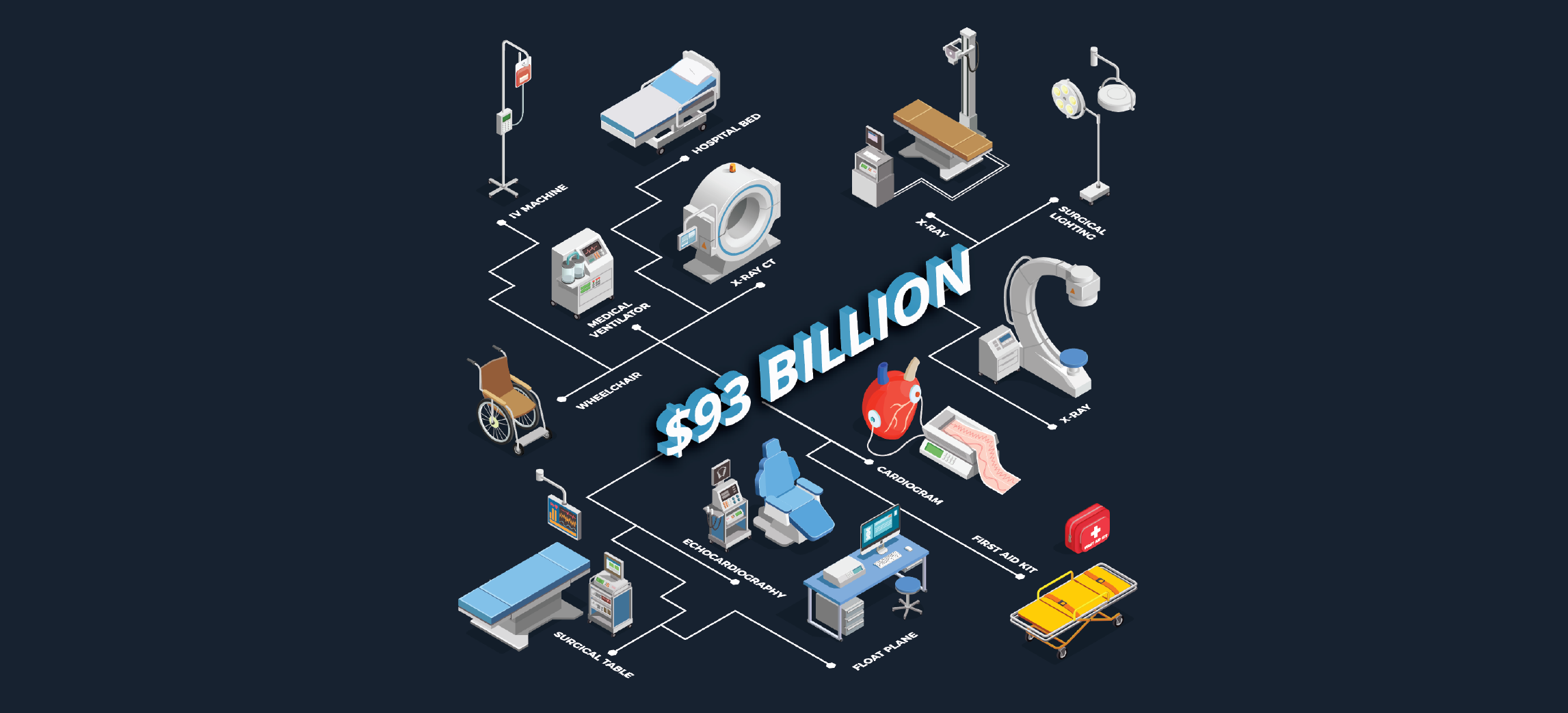
Hospitals often have diverse systems and siloed data making it complex and time-consuming to pull all of their data sources together. From legacy systems to new technology, reporting requirements, system upgrades, and interface issues, making sense of the disconnected data can be nearly impossible.
A unified system can help healthcare organizations make more efficient use of both medical devices and IT staff time. This visibility is even more important as hospitals increasingly rely on medical devices to help monitor and manage their patients’ care remotely.
The problem with traditional TEM
When using a Traditional Telecom Expense Management vendor to help optimize your IT expenses, there are three problems you will likely encounter:
- Focus on one-time cost savings through carrier optimizations
- Diminishing value after year 1
- Lack of automation + transparency
Traditional TEMs provide large savings in the beginning, but quickly fall off because the carrier cost optimizations only go so far. Beyond the first year, there is a need for automation to quickly deploy and manage devices, as well as transparency into cost allocation so that decision-makers can align IT spend and initiatives with overall strategic goals. Identifying opportunities for efficiencies through workflow automation is a critical piece of enabling technology across the healthcare sector.

Download the full guide with actionable checklists to help optimize your IT budget
Device security and compliance in healthcare
Outdated operating systems device security and compliance in healthcare
Managing IoT security is a challenge in any industry, but in healthcare, the stakes are far higher. Medical device vulnerabilities represent a threat greater than just financial, informational, or reputational damage. In the absence of proven endpoint protection, security vulnerabilities can impact people’s safety, and even have life-and-death implications.
Research shows that a key portion of exposed healthcare systems still use outdated operating systems, which makes them far more susceptible to threats. A study of 1.2 million Internet of Things (IoT) devices in healthcare and other enterprises found that fifty-six percent of imaging devices run on Win 7, which gets limited support and patching from Microsoft, and another 27% of these devices run on the long-dead Windows XP, as well as old and decommissioned versions of Linux, Unix, Windows, and other embedded software. Without these necessary updates, the devices and all the data on them, are at risk.
“The challenge is in identifying all of your organization’s vulnerable infrastructure and developing a plan for how to secure it. No one is thinking about a CT scanner or an MRI machine and seeing a launchpad for a broader attack.”
Anthony James
TRAPX

Protecting personal health information
According to Forbes, information security risk exposure tops all priorities. A single person’s personal health information is worth at least 25 times more than a credit card’s information on the black market, turning healthcare organizations into prime targets. A security breach in the US costs almost twice as much compared to other countries, so CIOs must ensure that security exposures don’t affect financial results.
The numbers revealed by a new Bitglass study are nevertheless eye-popping; an increase of cyberattacks of over 55% in 2020, with an estimated impact to the protected health information (PHI) of some 26 million people in the United States.
Adoption of IoT brings additional security risks, with healthcare organizations finding security a major headache. 89% of healthcare organizations that have adopted IoT said they have suffered a security breach as a result, while 49% said malware was an issue.
IT expense management leaders under pressure to optimize budget year-over-year must consider the risks of de-allocating budget to security. Rather, look to opportunities to save budget dollars in other areas so that you can invest more money toward security.

Unified endpoint management
As we have seen, mobile environments are becoming more complex (laptops, desktops, tablets, smartphones, IoT, wearables, etc.). Managing a wide variety of devices can be a burden on IT teams, creating breakdowns in efficiency across your organization. With the average cost of a data breach nearly $4 million, the need for security solutions is paramount. A unified endpoint management (UEM) solution can assist in securing, deploying, and managing corporate devices to ensure your admins and end-users don’t waste time on tedious tasks and you don’t suffer a costly data breach.
Leveraging a UEM solution allows your organization to integrate asset inventories and actions from leading providers through robust carrier integrations. You gain peace of mind that your mobile endpoints are secure and save time with automated processes.
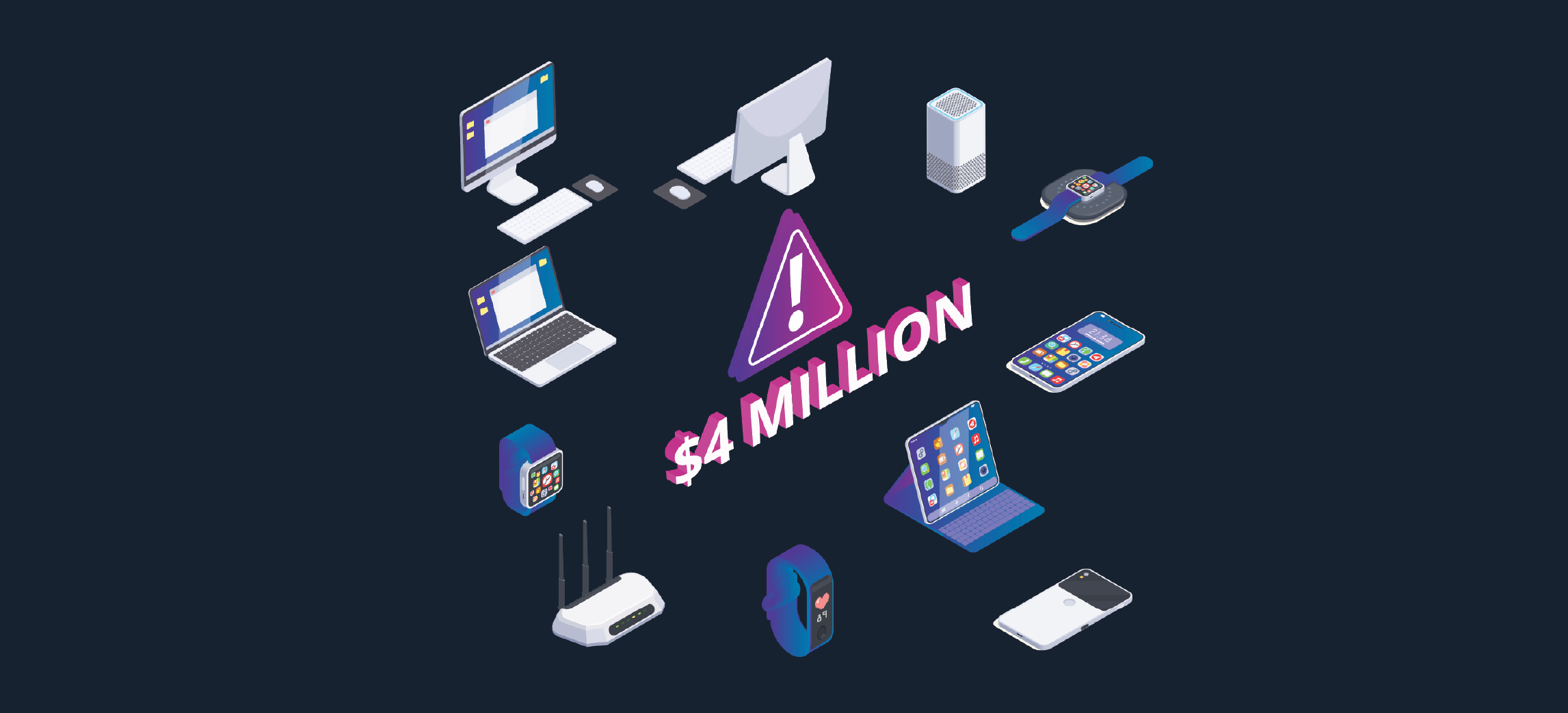
Security, compliance, and privacy – Deploy security and compliance policies that fit your environment and combine them with industry-leading strategies to ensure employee privacy is maintained while your data is secure.
Enterprise data management – Implement data loss prevention (DLP) policies and lock down endpoints to ensure your confidential data doesn’t fall into the wrong hands.
App and document management – Centralize and securely deliver critical documents and apps to your workforce, meaning none of your users are left in the dark.
So how do you drive down IT budget year over year?
We’ve seen the impact of technology adoption in the healthcare space. With this level of digital transformation, technology spend continues to skyrocket. IT leaders are tasked with managing increasingly complex budgets, split across multiple teams and initiatives.
So how do you solve these technology challenges and drive down your budget?
Download the full guide to answer some questions and work through our device management checklist. In the guide, you’ll also find insights into how your peers are optimizing IT budgets.


